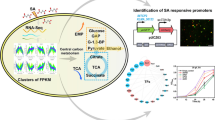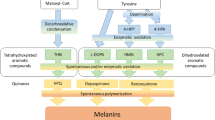Abstract
Quorum sensing molecular γ-butyrolactones (GBL) are widely distributed among the genus Streptomyces. Their cognate receptors have been demonstrated to control secondary metabolism and/or morphological differentiation. ScgA is responsible for the biosynthesis of GBL in Streptomyces chattanoogensis. According to the genome-wide transcriptome analysis of the ΔscgA mutant, we found that the expression of sprA, which encodes a GBL receptor homologue, was shown to be positively regulated by ScgA. Electrophoretic mobility shift assays and DNase I footprinting assays showed that SprA bound to two specific autoregulatory element (ARE) sequences located upstream of the sprA gene, indicating that its expression is self-regulated. SprA was involved in biosynthesis of GBL by repressing the expression of scgA. An Escherichia coli-based luciferase report system demonstrated that SprA directly repressed the expression of scgR, which encodes a GBL receptor. Like deletion of scgA, the disruption of sprA resulted in decreased production of the antibiotic natamycin in liquid culture and retarded morphological differentiation on solid agar. This work indicates that SprA acts as a pleiotropic regulator of both morphogenesis and the production of natamycin.









Similar content being viewed by others
References
Ahn SK, Tahlan K, Yu Z, Nodwell J (2007) Investigation of transcription repression and small-molecule responsiveness by TetR-like transcription factors using a heterologous Escherichia coli-based assay. J Bacteriol 189(18):6655–6664. doi:10.1128/Jb.00717-07
Bailey TL, Boden M, Buske FA, Frith M, Grant CE, Clementi L, Ren JY, Li WW, Noble WS (2009) MEME SUITE: tools for motif discovery and searching. Nucleic Acids Res 37:W202–W208. doi:10.1093/Nar/Gkp335
Baltz RH (1998) Genetic manipulation of antibiotic-producing Streptomyces. Trends Microbiol 6(2):76–83. doi:10.1016/S0966-842x(97)01161-X
Bjarnason J, Southward CM, Surette MG (2003) Genomic profiling of iron-responsive genes in Salmonella enterica serovar typhimurium by high-throughput screening of a random promoter library. J Bacteriol 185(16):4973–4982. doi:10.1128/Jb.185.16.4973-4982.2003
Bralley P, Jones GH (2003) Overexpression of the polynucleotide phosphorylase gene (pnp) of Streptomyces antibioticus affects mRNA stability and poly(A) tail length but not ppGpp levels. Microbiol-SGM 149:2173–2182. doi:10.1099/mic.0.26334-0
Czajkowski R, Jafra S (2009) Quenching of acyl-homoserine lactone-dependent quorum sensing by enzymatic disruption of signal molecules. Acta Biochim Pol 56(1):1–16
Delves-Broughton J, Thomas LV, Williams G (2006) Natamycin as an antimycotic preservative on cheese and fermented sausages. Food Aust 58(1–2):19–21
Du YL, Chen SF, Cheng LY, Shen XL, Tian Y, Li YQ (2009) Identification of a novel Streptomyces chattanoogensis L10 and enhancing its natamycin production by overexpressing positive regulator ScnRII. J Microbiol 47(4):506–513. doi:10.1007/s12275-009-0014-0
Du YL, Li SZ, Zhou Z, Chen SF, Fan WM, Li YQ (2011a) The pleitropic regulator AdpAch is required for natamycin biosynthesis and morphological differentiation in Streptomyces chattanoogensis. Microbiol-SGM 157:1300–1311. doi:10.1099/Mic.0.046607-0
Du YL, Shen XL, Yu P, Bai LQ, Li YQ (2011b) γ-butyrolactone regulatory system of Streptomyces chattanoogensis links nutrient utilization, metabolism, and development. Appl Environ Microb 77(23):8415–8426. doi:10.1128/Aem.05898-11
Edgar R, Domrachev M, Lash AE (2002) Gene Expression Omnibus: NCBI gene expression and hybridization array data repository. Nucleic Acids Res 30(1):207–210. doi:10.1093/Nar/30.1.207
Gottelt M, Hesketh A, Bunet R, Puri P, Takano E (2012) Characterisation of a natural variant of the γ-butyrolactone signalling receptor. BMC Res Notes 5:379. doi:10.1186/1756-0500-5-379
Gust B, Chandra G, Jakimowicz D, Tian YQ, Bruton CJ, Chater KF (2004) λ red-mediated genetic manipulation of antibiotic-producing Streptomyces. Adv Appl Microbiol 54:107–128. doi:10.1016/S0065-2164(04)54004-2
Horinouchi S (2002) A microbial hormone, A-factor, as a master switch for morphological differentiation and secondary metabolism in Streptomyces griseus. Front Biosci 7:D2045–D2057. doi:10.2741/Horinouc
Hsiao NH, Nakayama S, Merlo ME, de Vries M, Bunet R, Kitani S, Nihira T, Takano E (2009) Analysis of two additional signaling molecules in Streptomyces coelicolor and the development of a butyrolactone-specific reporter system. Chem Biol 16(9):951–960. doi:10.1016/j.chembiol.2009.08.010
Kato JY, Miyahisa I, Mashiko M, Ohnishi Y, Horinouchi S (2004) A single target is sufficient to account for the biological effects of the A-factor receptor protein of Streptomyces griseus. J Bacteriol 186(7):2206–2211. doi:10.1128/Jb.186.7.2203-2211.2004
Kieser T, Bibb M, Buttner M, Chater K, Hopwood D (2000) Practical Streptomyces genetics. The John Innes Foundation, Norwich, UK
Kinoshita H, Tsuji T, Ipposhi H, Nihira T, Yamada Y (1999) Characterization of binding sequences for butyrolactone autoregulator receptors in streptomycetes. J Bacteriol 181(16):5075–5080
Larkin MA, Blackshields G, Brown NP, Chenna R, McGettigan PA, McWilliam H, Valentin F, Wallace IM, Wilm A, Lopez R, Thompson JD, Gibson TJ, Higgins DG (2007) Clustal W and clustal X version 2.0. Bioinformatics 23(21):2947–2948. doi:10.1093/bioinformatics/btm404
Liu G, Chater KF, Chandra G, Niu GQ, Tan HR (2013) Molecular regulation of antibiotic biosynthesis in Streptomyces. Microbiol Mol Biol Rev 77(1):112–143. doi:10.1128/Mmbr.00054-12
Matsuno K, Yamada Y, Lee CK, Nihira T (2004) Identification by gene deletion analysis of barB as a negative regulator controlling an early process of virginiamycin biosynthesis in Streptomyces virginiae. Arch Microbiol 181(1):52–59. doi:10.1007/s00203-003-0625-5
Mehra S, Charaniya S, Takano E, Hu WS (2008) A bistable gene switch for antibiotic biosynthesis: the butyrolactone regulon in Streptomyces coelicolor. PLoS ONE 3(7):e2724. doi:10.1371/Journal.Pone.0002724
Nakano H, Takehara E, Nihira T, Yamada Y (1998) Gene replacement analysis of the Streptomyces virginiae barA gene encoding the butyrolactone autoregulator receptor reveals that BarA acts as a repressor in virginiamycin biosynthesis. J Bacteriol 180(13):3317–3322
Natsume R, Ohnishi Y, Senda T, Horinouchi S (2004) Crystal structure of a γ-butyrolactone autoregulator receptor protein in Streptomyces coelicolor A3(2). J Mol Biol 336(2):409–19
Nishida H, Ohnishi Y, Beppu T, Horinouchi S (2007) Evolution of γ-butyrolactone synthases and receptors in Streptomyces. Environ Microbiol 9(8):1986–1994. doi:10.1111/j.1462-2920.2007.01314.x
Ohnishi Y, Yamazaki H, Kato JY, Tomono A, Horinouchi S (2005) AdpA, a central transcriptional regulator in the A-factor regulatory cascade that leads to morphological development and secondary metabolism in Streptomyces griseus. Biosci Biotech Bioch 69(3):431–439. doi:10.1271/Bbb.69.431
Rigali S, Titgemeyer F, Barends S, Mulder S, Thomae AW, Hopwood DA, van Wezel GP (2008) Feast or famine: the global regulator DasR links nutrient stress to antibiotic production by Streptomyces. EMBO Rep 9(7):670–675. doi:10.1038/embor.2008.83
Rioseras B, Lopez-Garcia MT, Yague P, Sanchez J, Manteca A (2014) Mycelium differentiation and development of Streptomyces coelicolor in lab-scale bioreactors: programmed cell death, differentiation, and lysis are closely linked to undecylprodigiosin and actinorhodin production. Bioresour Technol 151:191–198. doi:10.1016/j.biortech.2013.10.068
Takano E, Chakraburtty R, Nihira T, Yamada Y, Bibb MJ (2001) A complex role for the γ-butyrolactone SCB1 in regulating antibiotic production in Streptomyces coelicolor A3(2). Mol Microbiol 41(5):1015–1028. doi:10.1046/j.1365-2958.2001.02562.x
Takano E, Tao M, Long F, Bibb MJ, Wang L, Li W, Buttner MJ, Bibb MJ, Deng ZX, Chater KF (2003) A rare leucine codon in adpA is implicated in the morphological defect of bldA mutants of Streptomyces coelicolor. Mol Microbiol 50(2):475–486. doi:10.1046/j.1365-2958.2003.3728.x
Xu DL, Seghezzi N, Esnault C, Virolle MJ (2010a) Repression of antibiotic production and sporulation in Streptomyces coelicolor by overexpression of a TetR family transcriptional regulator. Appl Environ Microbiol 76(23):7741–7753. doi:10.1128/Aem.00819-10
Xu GM, Wang JA, Wang LQ, Tian XY, Yang HH, Fan KQ, Yang KQ, Tan HR (2010b) "Pseudo" γ-Butyrolactone receptors respond to antibiotic signals to coordinate antibiotic biosynthesis. J Biol Chem 285(35):27440–27448. doi:10.1074/jbc.M110.143081
Yamada Y, Sugamura K, Kondo K, Yanagimoto M, Okada H (1987) The Structure of Inducing Factors for virginiamycin production in Streptomyces virginiae. J Antibiot 40(4):496–504
Yang YH, Song E, Kim EJ, Lee K, Kim WS, Park SS, Hahn JS, Kim BG (2009) NdgR, an IclR-like regulator involved in amino-acid-dependent growth, quorum sensing, and antibiotic production in Streptomyces coelicolor. Appl Microbiol Biotechnol 82(3):501–511. doi:10.1007/s00253-008-1802-x
Yang YH, Song E, Kim JN, Lee BR, Kim EJ, Park SH, Kim WS, Park HY, Jeon JM, Rajesh T, Kim YG, Kim BG (2012) Characterization of a new ScbR-like γ-butyrolactone binding regulator (SlbR) in Streptomyces coelicolor. Appl Microbiol Biotechnol 96(1):113–121. doi:10.1007/s00253-011-3803-4
Acknowledgments
This work was supported by Key Program of Zhejiang Provincial Natural Science Foundation of China (LZ12C01001), National High Technology Research and Development Program of China (863 Program, 2012AA02A706), National Basic Research Program of China (973 Program, 2012CB721005), and Specialized Research Fund for the Doctoral Program of Higher Education (No. 20120101110143).
We sincerely thank Professor Ke-Qian Yang (Institute of Microbiology, Chinese Academy of Science) for providing the plasmids pACYC184 and pCS26-pac. We are grateful to Professor Qing-Qing Wang (School of Basic Medical Sciences, Zhejiang University) for measuring luciferase. We deeply appreciate the critical advice of Dr. Yi-Ling Du on this work.
Author information
Authors and Affiliations
Corresponding author
Electronic supplementary material
Below is the link to the electronic supplementary material.
ESM 1
(PDF 229 kb)
Rights and permissions
About this article
Cite this article
Zhou, ZX., Xu, QQ., Bu, QT. et al. Transcriptome-guided identification of SprA as a pleiotropic regulator in Streptomyces chattanoogensis . Appl Microbiol Biotechnol 99, 1287–1298 (2015). https://doi.org/10.1007/s00253-014-6132-6
Received:
Revised:
Accepted:
Published:
Issue Date:
DOI: https://doi.org/10.1007/s00253-014-6132-6




